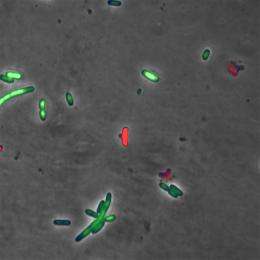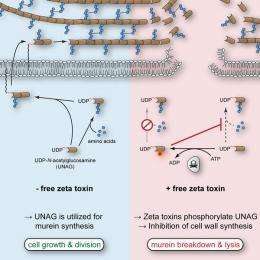Bacteria poison themselves from within

(PhysOrg.com) -- The research group led by Anton Meinhart at the Max Planck Institute for Medical Research in Heidelberg has shown that proteins from the zeta toxin group trigger a self-destructive mechanism in bacteria. The triggers for this bacterial suicide are toxin/antitoxin systems that play an important role in the hereditary transmission of resistance and virulence genes. The scientists have thus found a valuable new tool for the development of new broad-spectrum antibiotics.
A small number of genes can make dangerous killers out of innocuous bacteria. Genes that carry pathogenic properties or resistance to antibiotics can be transmitted from bacterium to bacterium by means of so-called mobile genetic elements. However, these elements often also contain genes for toxins and the corresponding antitoxins. “The mobile genetic elements are a two-edged sword to the bacteria: they help them survive, but can also kill them”, says Anton Meinhart from the Heidelberg institute.
The PezAT (pneumococcal epsilon zeta antitoxin toxin) system is a particularly interesting toxin/antitoxin system of the pathogen Streptococcus pneumoniae. These bacteria, which are also termed pneumococci, cause serious infections such as pneumonia, septicaemia and meningitis. The toxin component PezT belongs to the family of zeta toxins; these are known to stabilise mobile genetic elements which transmit resistance in many other pathogens. Although the zeta toxin family was discovered almost 20 years ago, its deadly mechanism had remained a mystery until now. The toxins seemed to attack a very early cellular process since, besides bacteria, they are able to kill off both yeast and cancer cells.

However, the Max Planck scientists have now managed to explain the molecular mode of action of zeta toxins using the model bacterium Escherichia coli. As it turned out, bacterial cells in which PezT was activated artificially showed symptoms of poisoning similar to those occurring after treatment with the well-known antibiotic penicillin: at the beginning of the PezT poisoning, most of the cells stalled in the middle of their division stage. After a period of time, the intersection between the two cell bodies burst and the cells died.
After further investigation, the scientists found that PezT and other zeta toxins are novel enzymes that transform the essential sugar building block UNAG (UDP-N-acetylglucosamine) into a toxic molecule. The toxin (UNAG-3P), very much like penicillin, inhibits the growth of the bacterial cell wall, causing the cells to burst and die. This process of internal cell activation could bring research on antibiotics a major step forward in the battle against bacterial resistance.
The zeta toxins are the first known enzymes known to poison bacteria from within by producing a ’suicide antibiotic‘. Since the building block UNAG is responsible for the growth of the cell wall in all known bacteria, this discovery explains the broad effectiveness of zeta toxins, or more specifically, UNAG-3P. It also makes the newly discovered substance UNAG-3P a valuable basic material for the development of innovative broad-spectrum antibiotics. In a next step, the scientists therefore want to determine whether UNAG-3P can be used as a new effective antibiotic.
Moreover, their discovery enabled the scientists to explain a hitherto paradoxical phenomenon: namely, that the supposedly lethal pneumococcal zeta toxin PezT boosts the pneumococcal infection rate. The reason for this is probably that an activation of PezT causes the bacterium to burst, and thereby releases its constituents. In this process, one of the most important pneumococcal toxins, pneumolysin, can spread and cause severe inflammation. It therefore seems that individual pneumococci sacrifice themselves for the good of the total population in the battle against the immune system.
More information: Hannes Mutschler, Maike Gebhardt, Robert L. Shoeman, Anton Meinhart, A Novel Mechanism of Programmed Cell Death in Bacteria by Toxin – Antitoxin Systems Corrupts Peptidoglycan Synthesis, PLoS Biology March 23, 2011
Provided by Max Planck Society





















